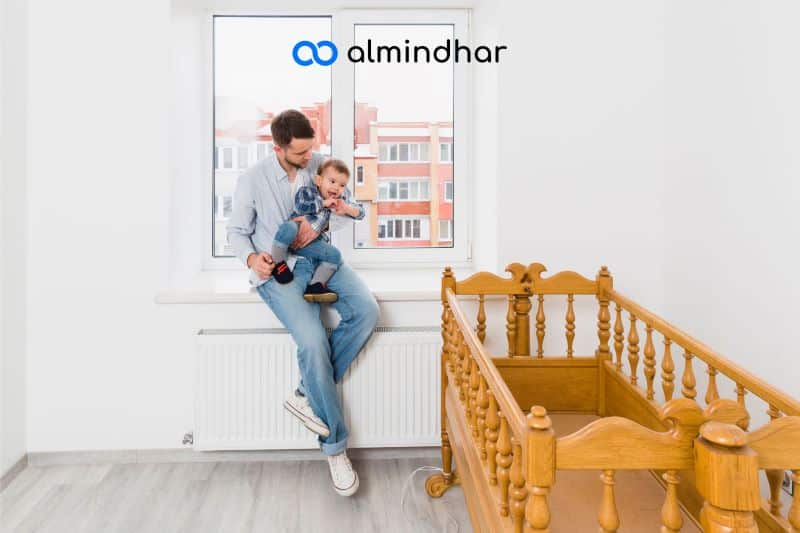The nursery is a vital space that needs to be functional, safe, and inviting. Whether you are expectant parents or planning to redesign your child’s room, furnishing a nursery can be both an exciting and delicate task. This guide provides practical and detailed advice to help you create a comfortable and secure environment for your little one.
- I-Space Planning
- 1-Choosing the Right Location
- 2-Creating a Functional Layout
- II-Essential Furniture
- 1-The Crib
- 2-The Changing Table
- 3-The Dresser and Wardrobe
- 4-The Nursing Chair
- III-Accessories and Decoration
- 1-Lighting
- 2-Textiles
- 3-Toys and Accessories
- 4-Safety Devices
- IV-Practical Tips for Layout
- 1-Prioritizing Simplicity
- 2-Choosing Convertible Furniture
- 3-Considering the Future
- 4-Creating a Calming Atmosphere
- V-Conclusion
I-Space Planning
1-Choosing the Right Location
Start by selecting the most suitable room in your home. Ideally, the baby’s room should be close to your own bedroom to facilitate nighttime trips. Ensure that the room has good ventilation and sufficient natural light.
2-Creating a Functional Layout
Plan the layout of the room with accessibility and safety in mind. Consider the flow of traffic within the room and position the furniture so that you can easily access the baby’s crib, changing table, and wardrobe.
II-Essential Furniture
1-The Crib
The crib serves as the focal point of the room. Opt for a crib that meets safety standards, ensuring that the slats are spaced no more than 6 cm apart to prevent the baby from getting stuck. Choose a firm, snug-fitting mattress to mitigate the risk of suffocation.
2-The Changing Table
A sturdy changing table is essential for diaper changes, positioned at a comfortable height to prevent back strain. Opt for models with raised edges to prevent the baby from rolling off. Changing tables with integrated drawers or shelves are convenient for storing diapers, wipes, and other essential items.
3-The Dresser and Wardrobe
A dresser or wardrobe is essential for storing baby clothes. Opt for furniture with soft-closing drawers to prevent pinching. Label the drawers to organize clothes by size or type.
4-The Nursing Chair
A comfortable nursing chair is ideal for breastfeeding or bottle-feeding moments. Choose a chair with armrests and good lumbar support. A footrest can also be a comfortable addition.

III-Accessories and Decoration
1-Lighting
The lighting in the baby’s room should be soft and soothing. Use lamps with dimmers to adjust brightness. A nightlight is useful for nighttime, providing gentle illumination without disturbing the baby’s sleep.
2-Textiles
Opt for soft and hypoallergenic textiles. Bed sheets, blankets, and curtains should be easy to wash. Pastel colors and soothing patterns can create a serene atmosphere.
3-Toys and Accessories
Incorporate a few age-appropriate toys and accessories. Plush toys, mobiles above the crib, and illustrated books can stimulate the baby’s senses and development.
4-The Nursing Chair
Ensure that all furniture is securely anchored to the wall to prevent tipping. Use corner guards on furniture with sharp angles and outlet covers for electrical sockets.
IV-Practical Tips for Layout
1-Prioritizing Simplicity
Avoid overloading the baby’s room with excessive furniture or decorations. A clear space is safer and easier to clean. Focus on the essentials and add items as needed over time.
2-Choosing Convertible Furniture
Choose convertible furniture that can grow with your child. For example, a convertible crib that can be turned into a toddler bed or a changing table that can be transformed into a dresser.
3-Considering the Future
Anticipate your child’s future needs by selecting versatile furniture. A spacious wardrobe can serve as storage for toys and clothes as your child grows.
4-Creating a Calming Atmosphere
Use soft and neutral colors to create a calm and soothing atmosphere. Pastel tones such as light blue, mint green, or blush pink are ideal for a baby’s room.
V-Conclusion
Designing a baby’s room is a wonderful journey that requires careful planning and thoughtful choices. By prioritizing safety, comfort, and functionality, you’ll create a welcoming and peaceful space for your little one. Don’t forget to personalize the room with decorative touches that reflect your style and that of your baby. With these tips, you’re ready to transform a simple room into a true haven of well-being for your child.



